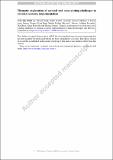| dc.contributor.author | Singh, Shweta | |
| dc.contributor.author | Babbitt, Callie | |
| dc.contributor.author | Gaustad, Gabrielle | |
| dc.contributor.author | Eckelman, Matthew J | |
| dc.contributor.author | Gregory, Jeremy | |
| dc.contributor.author | Ryen, Erinn | |
| dc.contributor.author | Mathur, Nehika | |
| dc.contributor.author | Stevens, Miriam C | |
| dc.contributor.author | Parvatker, Abhijeet | |
| dc.contributor.author | Buch, Raj | |
| dc.contributor.author | Marseille, Alicia | |
| dc.contributor.author | Seager, Thomas | |
| dc.date.accessioned | 2021-11-01T14:33:35Z | |
| dc.date.available | 2021-11-01T14:33:35Z | |
| dc.date.issued | 2021-01-26 | |
| dc.identifier.uri | https://hdl.handle.net/1721.1/136819 | |
| dc.description.abstract | Abstract
Circular economy (CE) offers a pathway towards sustainable, closed-loop resource systems, but widespread adoption across industrial sectors is limited by fragmented knowledge and varied implementation approaches. This article reviews sector-specific challenges and opportunities associated with implementing and measuring the benefits of CE strategies. Literature mapping highlights progress towards CE implementation in food, chemicals, metals, consumer electronics, and building and infrastructure sectors, and towards measuring CE outcomes via systems analysis methods like life cycle assessment (LCA) and material flow analysis (MFA). However, key challenges were also identified that point to future research and demonstration needs. First, research on CE adoption typically exists as case studies that are closely linked to a sector. But literature has not effectively synthesized knowledge gained across domains, particularly understanding underlying barriers to CE and where they occur in product life cycles. Second, research on CE outcomes often applies well-established methods without adapting for unique attributes of CE systems. A key opportunity is in integrative methodological advances, such as expanded use of consequential LCA, development of physical Input–Output tables, and integrating MFA with dynamical models. Finally, regardless of sector, new CE business models are seen as a critical enabler to realize success, but theoretical frameworks in literature are not well-tested in practice. The review also highlights opportunities to harness other emerging trends, such as big data, to provide better information for system modelers and decision-oriented insight to guide CE stakeholders.
Graphic abstract | en_US |
| dc.publisher | Springer Berlin Heidelberg | en_US |
| dc.relation.isversionof | https://doi.org/10.1007/s10098-020-02016-5 | en_US |
| dc.rights | Article is made available in accordance with the publisher's policy and may be subject to US copyright law. Please refer to the publisher's site for terms of use. | en_US |
| dc.source | Springer Berlin Heidelberg | en_US |
| dc.title | Thematic exploration of sectoral and cross-cutting challenges to circular economy implementation | en_US |
| dc.type | Article | en_US |
| dc.contributor.department | Massachusetts Institute of Technology. Department of Civil and Environmental Engineering | |
| dc.eprint.version | Author's final manuscript | en_US |
| dc.type.uri | http://purl.org/eprint/type/JournalArticle | en_US |
| eprint.status | http://purl.org/eprint/status/PeerReviewed | en_US |
| dc.date.updated | 2021-04-13T03:26:15Z | |
| dc.language.rfc3066 | en | |
| dc.rights.holder | The Author(s), under exclusive licence to Springer-Verlag GmbH, DE part of Springer Nature | |
| dspace.embargo.terms | Y | |
| dspace.date.submission | 2021-04-13T03:26:14Z | |
| mit.license | PUBLISHER_POLICY | |
| mit.metadata.status | Authority Work and Publication Information Needed | |
